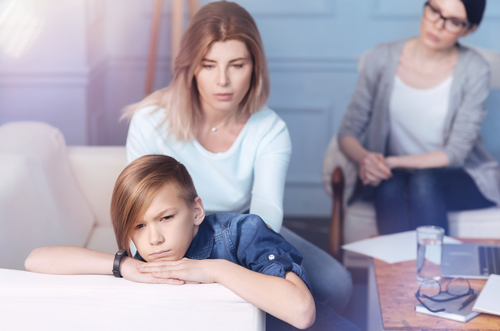What if I told you there is another way to respond to your child’s meltdowns that left you feeling calmer, closer, and more competent as a parent? Does it sound like one of those strategies that might work for someone else but not with your kids? Read on.
The Brain’s Response to Stress
First, let’s talk about brain development and the learning process for a minute. Hang on, because we are about to get a bit technical. You will want this information for where we are headed. Through neuroscience, we have discovered that there are three main areas of the brain: the brainstem, the limbic system, and the prefrontal cortex.
The Brainstem
The first part to develop is the brainstem, also known as the lizard brain, and it is fully formed in the infant at birth. It is responsible for basic instincts and functions to sustain life and movement. This area regulates processes such as breathing, digestion, heart rate, sleep, hunger, and body temperature. It is also responsible for the fight, flight, fawn and freeze responses. Infants operate from the survival center and are unable to regulate their own emotions or self soothe. They rely on attuned caregivers to provide comfort for their physical and emotional needs. When your baby wakes for the fifth time at night, it isn’t to manipulate you. They are still learning how to regulate themselves and they need a caregiver to show them how. Some kids learn fairly quickly, and other kids, especially highly sensitive children (HSC) (Is my child highly sensitive?) and neuro-diverse children (What is neurodiversity?), may take longer.
The Limbic System
The second part of the brain to develop is the limbic system, also known as the emotional brain. Toddlers and preschoolers operate primarily from the limbic system and the brainstem. This area processes memory, emotions, and the response to stress. It is responsible for nurturing, caring, separation anxiety, fear, rage, social bonding, and hormone control. They are feeling all kinds of emotions in response to new experiences and stressors, without the language to communicate them or the tools to manage them on their own. Toddler and preschoolers benefit from a caregiver who consistently provides comfort and a calm presence when they are upset.
The Prefrontal Cortex
The third part of the brain to develop is the prefrontal cortex, also knows as the executive center. This area is not fully developed until the mid-20’s. It is responsible for rational thought, problem solving, planning, attention, self awareness, and interpreting emotions. Brain scans of children with ADHD show alterations in the executive center. This is the reason individuals with ADHD have more difficulty with things like impulse control and attention. If you have a child with ADHD, work with a therapist to learn strategies that will help them be successful. Even with neurotypical children, this part of the brain is still a work in progress older children and teens can not be expected to be completely competent in handling frustration. They often still need a calming presence and guidance in navigating their emotions and experiences.
A Different Way of Responding
Now that we have that background, let’s come back to looking at how we can respond differently to our child’s meltdowns. In that scenario with the children fighting, their lizard and emotional brains have kicked into high gear, leaving little to no room for the executive center. You hear the piercing scream, which triggers your limbic system’s panic button (a.k.a. the amygdala), setting off the stress response system in the brainstem (fight, flight, freeze, fawn), and before you know it, you are yelling at your children to “calm down!”. This continues the activation of their limbic system and they may respond with an escalation of the fight response by yelling back and slamming doors or they may shut down into a flight or freeze response and start crying.
What Is Co-Regulation?
Using co-regulation to respond to your child’s meltdowns and the sibling fights will interrupt the stress response system and completely change the outcome. Co-regulation is simply calming yourself while you calm your child. It is joining them with empathy in their frustration and in finding a way to soothe themselves. It means setting aside, temporarily, the need to address the problem or correct the behavior. Learning is more effective when we feel safe and not overwhelmed by emotion.
Co-regulation often comes in the form of a physical outlet. For some, it may look like offering them a hug and then just holding them until the anger passes. Other children may need to pound on a pillow with you or go for a walk or a run. If the siblings are upset with one another, invite them to join you in letting off some steam in a safer way.
Before the next fight or meltdown happens, talk with your children about what they find helpful when they are feeling upset. Print out a list of creative anger management strategies for your child to choose from like this one from Mindful Mazing 55 Anger Management Tips for Kids. Hang it on the wall or write them on popsicle sticks to keep in a jar to pull when needed. In the moment, tell them that you can see they are upset and offer to join them in their activity. You might find it helpful to offer them a few options. If your child responds negatively, go ahead and try one of the calming strategies for yourself. Let your child know that you are feeling upset and this is how you take care of yourself. You may find they end up joining you eventually.
One Final Note
One thing to keep in mind is that parents of younger children will have an easier time of creating this new pattern of connecting when upset. Parents of older children who already have patterns of disconnection and escalation of anger in these situations, may find their child initially rejects the idea. Their brains have already created stress responses to certain situations that when triggered will set off their fight response. It will take more time to create new pathways. Think of co-regulation as a practice, rather than a magic wand. The more you model for them how to manage your own anger, the easier it will become.
If you have questions about how to implement these ideas with your child, reach out to one of our counselors. We would love to support your family in creating a more peaceful home.
Hannah Lindsay, MSW, LCSW, provides individual and family therapy in our Sterling, VA office and virtually to those located in Virginia. Call or email today to set up your first appointment or a complimentary consultation with Hannah.






